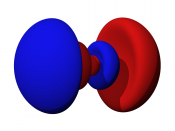Abstract:
The change in weight induced by a magnetic field for three solutions of complexes was recorded. The change in weight of a calibrating solution of 29.97% (W/W) of NiCl2 was recorded to calculate the apparatus constant as 5.7538. cv and cm for each solution was determined in order to calculate the number of unpaired electrons for each paramagnetic complex. Fe(NH4)2(SO4)2 6(H20) had 4 unpaired electrons, KMnO4 had zero unpaired electrons, and K3[Fe(CN)6] had 1 unpaired electron. The apparent 1 unpaired electron in K3[Fe(CN)6] when there should be five according to atomic orbital calculations arises from a strong ligand field produced by CN-.
Introduction:
The magnetic susceptibility is a phenomena that arises when a magnetic moment is induced in an object. This magnetic moment is induced by the presence of an external magnetic field. This induced magnetic moment translates to a change in the weight of the object when placed in the presence of an external magnetic field.
This induced moment may have two orientations: parallel to the external magnetic field of or perpendicular to the external magnetic field. The former is known as paramagnetism and the later is known as diamagnetism. The physical effect of paramagnetism is an attraction to the source of magnetism (increase in weight when measured by a Guoy balance) and the physical effect of diamagnetism is a repulsion from the source of magnetic field (decrease in weight when measured by a Guoy balance).
The observed magnetic moment is derived by the change in weight. This observed magnetic moment arises from a combination of the orbital and spin moments of the electrons in the sample with the spin component being the most important source of the magnetic moment. This magnetic moment is caused by the spinning of an electron around an axis acting like...


